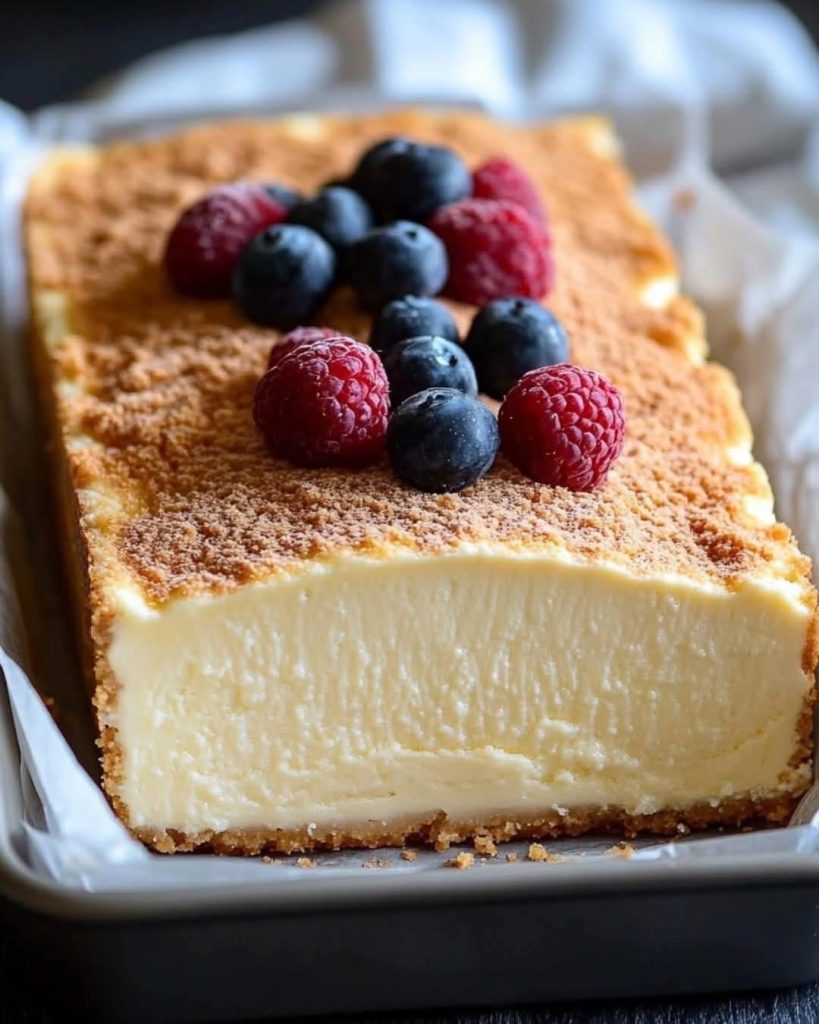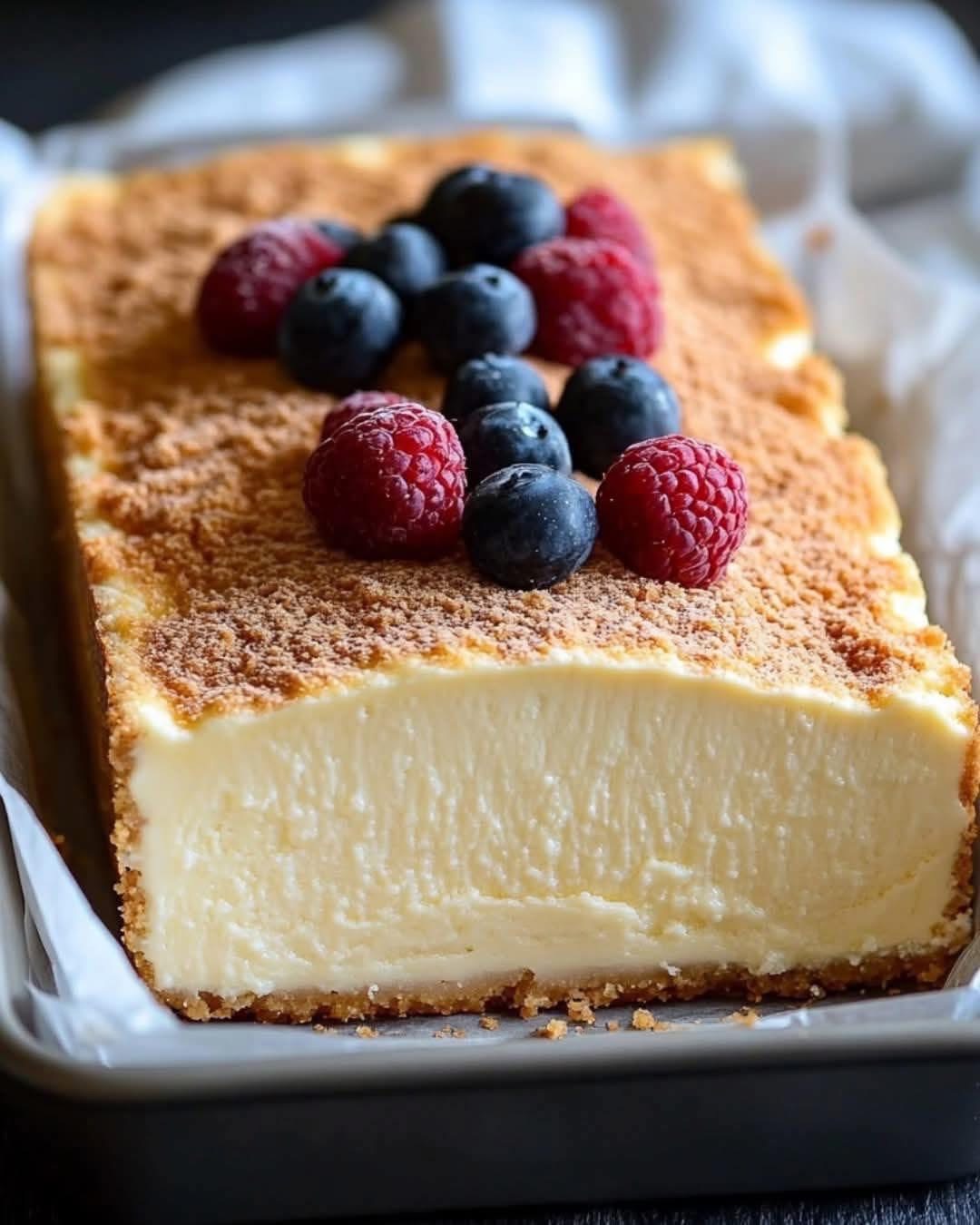Baked Cheesecake

Introduction
Baked cheesecake is a rich, creamy, and indulgent dessert that has won the hearts of dessert lovers worldwide. Unlike no-bake cheesecake, this version is made by baking a mixture of cream cheese, eggs, sugar, and other ingredients to create a firm yet velvety texture. Originating from ancient Greece and later perfected in modern-day New York, cheesecake has become a global favorite, often served with fruit toppings, chocolate drizzle, or a simple dusting of crumbs.
Ingredients
For the Crust:
- 2 cups crushed graham crackers or digestive biscuits
- 1/2 cup melted butter
- 2 tbsp sugar
For the Cheesecake Filling:
- 500g (2 cups) cream cheese, softened
- 1 cup sugar
- 3 large eggs
- 1 cup sour cream
- 1 tsp vanilla extract
- 2 tbsp all-purpose flour
For the Topping:
- 1/2 cup blueberries
- 1/2 cup raspberries
- 2 tbsp powdered sugar (optional)
Instructions
Step 1: Preparing the Crust
- Preheat your oven to 175°C (350°F).
- In a bowl, mix crushed graham crackers, melted butter, and sugar until it resembles wet sand.
- Press the mixture into the bottom of a lined baking pan to form a firm crust.
- Bake for 10 minutes, then let it cool.
Step 2: Making the Cheesecake Filling
- Beat the softened cream cheese and sugar together until smooth.
- Add the eggs one at a time, beating well after each addition.
- Mix in the sour cream, vanilla extract, and flour until fully combined.
Step 3: Baking the Cheesecake
- Pour the filling over the cooled crust.
- Tap the pan gently on the counter to remove air bubbles.
- Bake for 50–60 minutes or until the center is slightly jiggly but set.
- Turn off the oven and let the cheesecake cool inside for an hour to prevent cracking.
Step 4: Chilling & Serving
- Refrigerate the cheesecake for at least 4 hours, preferably overnight.
- Garnish with fresh blueberries and raspberries before serving.
- Dust with powdered sugar for an extra touch of sweetness
Methods of Making Cheesecake
Cheesecake can be made using different methods, each producing a unique texture and flavor. Below are the most common methods used for making cheesecake:
1. Baked Cheesecake Method
This is the traditional way of making cheesecake, resulting in a firm yet creamy texture.
Steps:
- Prepare the crust: Mix crushed graham crackers (or biscuits) with melted butter and press them into the base of a baking pan.
- Make the filling: Beat cream cheese, sugar, eggs, vanilla extract, and sour cream until smooth.
- Bake: Pour the filling over the crust and bake at 150-175°C (300-350°F) for 50-60 minutes.
- Cooling process: Turn off the oven and leave the cheesecake inside with the door slightly open for an hour to prevent cracks.
- Chill: Refrigerate for at least 4-6 hours before serving. Best for: Classic, rich, and creamy cheesecakes (New York-style).
2. No-Bake Cheesecake Method
This method skips baking and uses gelatin or whipped cream to set the cheesecake.
Steps:
- Prepare the crust: Mix crushed biscuits with melted butter and press into the pan. Chill in the refrigerator.
- Make the filling: Blend cream cheese, sugar, vanilla extract, and whipped cream (or gelatin for stability).
- Set in the fridge: Pour over the crust and refrigerate for at least 6 hours or overnight until firm.
Best for: Light, airy, and mousse-like cheesecakes.
3. Water Bath (Bain-Marie) Method
A technique used for baking cheesecakes gently to achieve an ultra-smooth texture without cracks.
Steps:
- Wrap the pan: Cover the bottom of the springform pan with aluminum foil to prevent water from seeping in.
- Place in a hot water bath: Set the pan inside a larger baking dish filled with 1-2 inches of hot water.
- Bake slowly: Use a low oven temperature (150°C / 300°F) for even cooking.
Best for: Silky, custard-like cheesecakes with a smooth top.
4. Steamed Cheesecake Method
A unique technique where cheesecake is steamed instead of baked.
Steps:
- Prepare the batter: Mix cream cheese, sugar, eggs, and milk into a smooth batter.
- Steam the cheesecake: Pour the batter into a mold and steam for 30-45 minutes over low heat.
- Cool & chill: Let it cool before refrigerating. Best for: Light, jiggly, and ultra-moist cheesecakes (popular in Japan).
5. Instant Pot (Pressure Cooker) Cheesecake
A modern way to cook cheesecake faster while keeping it creamy.
Steps:
- Prepare the batter as usual.
- Pour into a greased pan and cover with foil.
- Cook in an Instant Pot on high pressure for 30 minutes, followed by a natural release.
- Cool & refrigerate before serving.
Best for: Quick and easy cheesecake with a rich texture.
Which Method is Best?
- For a traditional, rich cheesecake → Baked Cheesecake (Water Bath for best results).
- For a light, mousse-like cheesecake → No-Bake Cheesecake.
- For an ultra-moist, soft texture → Steamed Cheesecake.
- For a quick and easy version → Instant Pot Cheesecake.
Each cheesecake-making method offers a unique experience. If you prefer a classic dense cheesecake, baking is the best option. If you want a refreshing, easy-to-make dessert, the no-bake method is perfect. Experiment with different techniques to find your favorite!
History of Cheesecake
The first recorded cheesecake dates back to ancient Greece, where it was served to athletes during the Olympic Games in 776 BC. Later, the Romans adopted the recipe, adding eggs and baking it. Over centuries, different cultures modified the recipe, with New York-style cheesecake becoming one of the most famous variations.
Health Benefits of Cheesecake
- Good Source of Protein: Cream cheese and eggs provide protein, essential for muscle building.
- Rich in Calcium: Supports bone health due to dairy ingredients.
- Energy-Boosting: Contains fats and sugars that provide quick energy.
- Antioxidant Properties: Berries used as toppings are packed with antioxidants
While cheesecake is often considered an indulgent treat, it does offer some nutritional benefits when consumed in moderation. Here are some of its health benefits:
1. Good Source of Protein
- Cheesecake contains cream cheese, eggs, and sour cream, all of which are rich in protein.
- Protein is essential for muscle repair, immune function, and overall body growth.
2. Rich in Calcium for Strong Bones
- Dairy ingredients like cream cheese and sour cream provide calcium, which is vital for bone and teeth health.
- Calcium also helps with muscle contractions and nerve signaling.
3. Provides Instant Energy
- Cheesecake contains carbohydrates and fats, which provide quick energy, making it a satisfying treat.
- The combination of fats and proteins also helps with satiety, keeping you full longer.
4. Contains Antioxidants (When Topped with Fruits)
- Topping your cheesecake with blueberries, raspberries, or strawberries increases its antioxidant content.
- Antioxidants help combat oxidative stress, reducing the risk of chronic diseases.
5. Boosts Mood and Happiness
- Desserts, including cheesecake, stimulate the production of serotonin, the “happiness” hormone.
- Enjoying a slice in moderation can lift your mood and reduce stress.
6. Supports Gut Health (When Made with Greek Yogurt)
- Some cheesecake recipes incorporate Greek yogurt, which contains probiotics that promote gut health.
- Probiotics support digestion and strengthen the immune system.
7. Customizable for Healthier Versions
- You can make a healthier cheesecake by using:
- Low-fat cream cheese to reduce saturated fat.
- Almond flour or oat flour instead of graham crackers for a fiber boost.
- Honey or maple syrup instead of refined sugar for natural sweetness.
While cheesecake should be enjoyed in moderation, it does provide valuable nutrients like protein, calcium, and antioxidants when made with wholesome ingredients. Pairing it with fruits and nuts can enhance its health benefits while still keeping it delicious!
Formation of Cheesecake (Texture & Structure)
Baked cheesecake has a dense yet creamy texture, achieved by slow baking and gradual cooling. The crust provides a slight crunch that contrasts with the smooth filling. Using a water bath can help maintain an even texture and prevent cracks.
Nutritional Information (Per Slice)
- Calories: 350-450 kcal
- Protein: 6-8g
- Carbohydrates: 40-50g
- Fats: 20-25g
- Sugar: 25-30g
Nutritional Information (Per Slice of Cheesecake – Approx. 100g Serving)
| Nutrient | Amount | % Daily Value (Approx.) |
|---|---|---|
| Calories | 350-450 kcal | 18-22% |
| Protein | 6-8g | 12-16% |
| Carbohydrates | 40-50g | 13-17% |
| Sugars | 25-30g | 50-60% |
| Fats | 20-25g | 30-38% |
| Saturated Fat | 10-12g | 50-60% |
| Cholesterol | 80-120mg | 25-40% |
| Calcium | 80-120mg | 8-12% |
| Fiber | 1-2g | 4-8% |
| Sodium | 200-300mg | 8-12% |
Nutritional Breakdown
- High in Calories: Cheesecake is energy-dense due to the combination of cream cheese, sugar, and butter in the crust.
- Moderate Protein Content: Provides 6-8g of protein per slice, mainly from eggs and dairy.
- Rich in Healthy Fats: Contains saturated fats from dairy, but you can opt for low-fat ingredients for a healthier version.
- High in Sugar: Traditional cheesecake contains a good amount of sugar, but it can be reduced by using natural sweeteners like honey or stevia.
- Good Source of Calcium: Thanks to the cream cheese and sour cream, each slice provides some calcium for bone health.
How to Make Cheesecake Healthier
- Use Greek yogurt instead of sour cream for added probiotics.
- Swap refined sugar with honey or maple syrup.
- Choose almond or oat flour for the crust instead of graham crackers.
- Use low-fat cream cheese to reduce saturated fat.
Cheesecake is an indulgent treat that provides calcium, protein, and energy, but it is high in sugar and fat. Enjoy it in moderation, and try healthier ingredient swaps for a more balanced dessert!
Why People Love Cheesecake
- Versatility: Can be flavored with chocolate, fruit, or caramel.
- Creamy & Indulgent: The perfect balance of smooth and rich.
- Timeless Classic: Enjoyed worldwide for generations.
- Customizable: Can be baked or made as a no-bake version.
Conclusion
Cheesecake is more than just a dessert—it’s a universal favorite that brings joy to any occasion. Whether you prefer classic, chocolate, or fruit-infused variations, this baked cheesecake recipe is a must-try. With a buttery crust and luscious filling, it’s a showstopper for any gathering!
